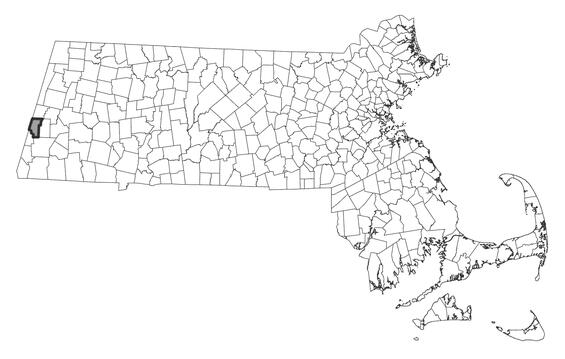- Scientific name: Blephilia ciliata
- Species of Greatest Conservation Need (MA State Wildlife Action Plan)
- Endangered (MA Endangered Species Act)
Description
Downy wood-mint, a member of the mint family (Labiatae or Lamiaceae), stands 30-60 cm (1-2 ft) tall with a closely pubescent (hairy) stem. The nearly odorless principal leaves measure 3-6 cm (1.2-2.4 in) long, are almost sessile (without a stalk), are narrowed at their base, and are whitish-downy beneath. In contrast, leaves of vegetative offshoots have long petioles (stalks to the leaf blade) and are nearly elliptical or oval. The calyx (outer floral envelope) is two-lipped and bilaterally symmetrical with three spine-tipped teeth on the upper side and two shorter blunter teeth on the lower side. The 11-14 mm (0.43-.0.55 in) long corollas are hairy and pink to bluish with purple spots and are arranged in 1-5 whorls on the upper part of the stem. Each whorl has at its base a row of fringed, colorful bracts. Blephilia ciliata gets its name from the Greek blepharis (the eyelash) in reference to the hairy fringe of the bracts.
B. ciliata resembles hairy wood-mint (B. hirsuta), but B. hirsuta is often taller, has whitish flowers, narrower bracts, a shorter, lower calyx, and the lobes don’t reach the upper sinuses. Wild Basil (Satureja vulgaris) is often mistaken for downy wood-mint and can be found in the same habitat. It is usually no more than 1 foot tall, has uniformly pink to rosy flowers, and the whorls lack the colorful bracts.

Population status
The MassWildife’s Natural Heritage & Endangered Species Program (NHESP) database has 4 records from 2 counties: Berkshire and Hampshire. Only 1 of these records has been observed within the last 25 years.
Distribution and abundance
Downy wood-mint occurs from Massachusetts to southern Michigan and Wisconsin, south to Georgia, Mississippi, and Arkansas.

Distribution in Massachusetts
1999-2024
Based on records in the Natural Heritage Database
Habitat
Downy wood-mint is usually found in moist or dry regenerating woods, thickets, and openings with open-filtered light. One subpopulation in Massachusetts is in open woods on a thickety edge of a trail with a canopy of white ash, white pine, and quaking aspen; a shrub border of dogwood (Cornus alternifolia), speckled alder (Alnus rugosa), and wild grape (Vitis sp.); and many herbs and weedy species: sweet clover (Melilotus), goldenrod (Solidago), horse mint (Monarda), Tinker’s weed (Triosteum), and wind-flower (Anemone). Another subpopulation is found in an abandoned quarry, in an open, grassy, weedy strip with similar associated plants.
Healthy habitats are vital for supporting native wildlife and plants. Explore habitats and learn about conservation and restoration in Massachusetts.
Threats
Forest succession, which may shade out downy wood-mint, poses a threat to the existing population in Massachusetts. Downy wood-mint is listed as rare in Canada, Delaware, Iowa, Illinois, Maryland, New York, and Vermont.
Contact
| Date published: | April 8, 2025 |
|---|